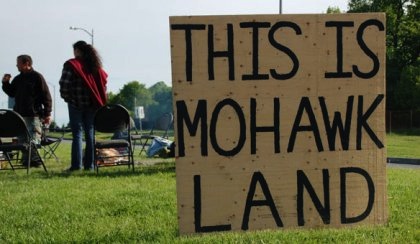Recent protests in Karachi against continued U.S. drone strikes should serve as a reminder that the violation of international law and Pakistani sovereignty in the interests of U.S. security predates the recent discovery and killing of Osama bin Laden. Under Bush and Obama, the U.S. government’s justification for these military operations is Pakistan’s unwillingness and inability to govern the tribal regions along its border with Afghanistan.
What is often less remarked upon is that Pakistan has served as a model for how to govern borderlands closer to home. The U.S. military has been deploying drones along the Mexican borderlands since 2006 and, more recently, along the Canadian border. The use of drones for surveillance, and possibly more, is only likely to increase. In a new report from the U.S. Government Accountability Office (GAO), the Canadian border is singled out as a major security threat that calls for more intervention on the part of the Department for Homeland Security (DHS).
In my contribution to the April 2011 issue of Anthropology Now, “Transnational Waste and its Discontents,” I discuss the politics of unwanted traffic along the U.S.-Canadian border. Specifically, I examine how waste imported from Canada to a rural Michigan community became a source of political controversy in the first decade of the twenty-first century:
“For many residents, Canadian waste took center stage as a meaningful trope for widespread fears about personal, economic, and environmental insecurity in a post-agrarian, post-industrial, post–housing-bubble world dominated by challenging new forms of global connection.” (Reno 2011: 23)
In that piece I suggest that, though less discussed in social science and public culture than the southern border with Mexico, the U.S.-Canadian border has generated its own unique predicaments over the last two centuries. Like the southern border, the U.S.-Canadian border has long been profoundly shaped by racial and ethnic politics, with the presence of indigenous people along the borderlands a perceived barrier to U.S. security and sovereignty throughout the nineteenth century that lingers still today. Much the same could be said of Alaska’s transcontinental border with Russia. As Sonja Luehrmann discusses in her first book, “Alutiiq villages under Russian and U.S. Rule” (2008), Alaska represents a hybrid zone where indigenous communities and contiguous empires square off.
Perhaps no part of the U.S. border is more representative of the complications surrounding sovereignty and citizenship in the Alaskan context than the Akwesasne territory along the St. Lawrence River. A Mohawk reservation that covers portions of New York State, Quebec and Ontario, Akwesasne has risen to prominence as a site of disputes concerning crime, settler and indigenous sovereignty, and jurisdictional authority.
In 2001, some Mohawks enabled Direct Action Network and other “anti-globalization” activists to cross the border into Quebec in anticipation of actions in Québec City surrounding the Summit of the Americas. More recently, the Mohawk community has appealed to the UN to stop Canadian officials from carrying guns in their territory, in violation of treaty.
Thus it should come as no surprise that the GAO choose Akwesasne as one of several border sectors they examined in a sweeping overview that called for the DHS to improve their oversight of interagency coordination in the area. Since a number of the agencies in question are tribal and Canadian, this calls for the jurisdiction of the “homeland” department to become larger indeed. In a Global Post special report last month, “Indian Reservation: a Smuggler’s Playground,” Lorraine Mallinder describes the difficulty of asserting the power of “Homeland Security” in such a context: “The sovereign Mohawk territory, with its traditional hostility toward outside authority is a fertile recruitment ground [for drug smugglers]. A roadside sign on one of the reservation’s main drags proclaims U.S. Border Patrol, New York State Police, the FBI and others to be ‘terrorists’.”
Mallinder’s focus is the way Akwesasne has been negatively affected by low employment opportunities and the drug trade. In Akwesasne, as in Pakistan, U.S. investment in security issues now trump any attention to the worsening quality of life in the region. As David Graeber recounts in his ethnography of the 2001 actions in Quebec, the Mohawks that the Direct Action Network worked with were as concerned, if not more, with environmental racism and ongoing toxic pollution from a nearby GM Plant, as they now are with things like border patrols, guns and drones. If it is the latter that are more discussed and resisted today, it is because they stand for the military might that allows their neighbors to keep on violating both their borders and their bodies.
One could argue, as does political scientist Peter Andreas, that since 9/11 the U.S.-Canadian border has undergone “Mexicanization”—by which he means an increasingly asymmetrical power swing. With the increasing use of militarized surveillance and security measures along the Canadian border, and the promise of more direct oversight from the DHS in the near future, perhaps one day we will have to go further abroad for our analogies and describe this as a process of “Pakistanization.”
Author Joshua Reno is a lecturer at Goldsmiths College, University of London, in the Department of Anthropology. He received his PhD from the University of Michigan in 2008. He has articles on waste, techno-science, and environmental politics appearing in Cultural Anthropology, American Ethnologist and Science, Technology and Human Values in 2011 and a book co-edited with Catherine Alexander on recycling economies expected from Zed Books in 2012.



